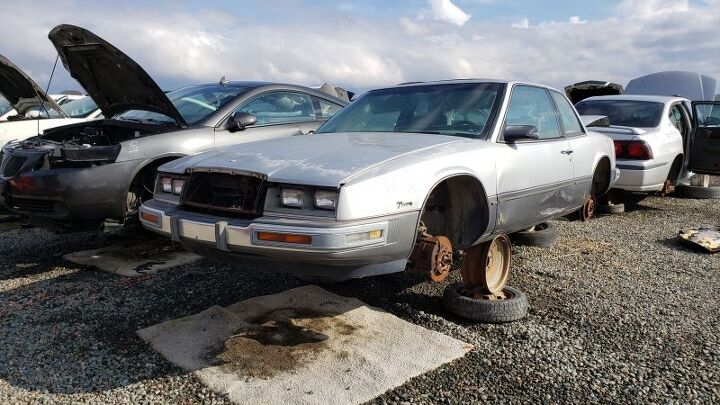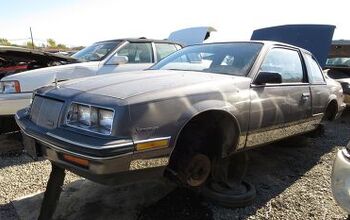Junkyard Find: 1986 Buick Riviera T-Type

The General’s Buick division went all futuristic starting in the middle 1980s, hoping to win back (younger) American buyers who were switching their loyalty to high-tech European machinery at that time. The sleek Reatta two-seater came along in the 1988 model year, but the 1986 Riviera (and, to a lesser extent, the Somerset) were the first models to get the science-fiction touch.
Here’s a maximum-options Riviera T-Type coupe, which came with 800-way power seats and a touchscreen computer interface, spotted in a Silicon Valley self-serve yard last month.
The T-Type name first appeared on the 1981 Riviera and spread to other Buick models as the 1980s went on. T-Types had sporty badges, bucket seats, and (often) performance-oriented mechanical upgrades.
Sunroofs were regarded as super-luxurious items in the 1970s and 1980s, and this car got a costly aftermarket installation immediately after purchase (or perhaps it was dealer-installed).
I found some paperwork in the car that led me to its final address. Here’s a Google Earth view of the car, with big sunroof, moldering away in a blocked-in driveway in suburbia. My guess is that it broke a decade ago and its owners finally ran out of motivation to get it fixed.
Crevices for dust and fast-food crumbs abound in these complex leather seats.
With a 140-horse 3.8-liter pushrod V6 driving the front wheels and no manual-transmission option, the 1986 Riviera lured away few BMW or Mercedes-Benz shoppers. Still, this car was a radical departure from the geriatric-grade Buicks that American car buyers had come to expect by the 1980s.
I’m not quite sure what to make of this drawing I found in the back seat.
This was the most expensive new Buick you could buy in 1986, listing at $21,577 (about $50,600 in 2019 dollars). That was pretty close to the cost of a new 1986 BMW 325es ($21,950) and you got 19 more horsepower with the Buick. However, the rear-wheel-drive Regal T-Type with turbocharged 3.8 engine had a mighty 235 horsepower in 1986 and its MSRP was a mere $13,714 (plus $635 if you wanted the Grand National appearance package, which you did).
This ad is sort of a combination of Top Gun and Close Encounters of the Third Kind.
If you like these Junkyard Finds, you’ll find links to 1,800+ more at the Junkyard Home of the Murilee Martin Lifestyle Brand™.

Murilee Martin is the pen name of Phil Greden, a writer who has lived in Minnesota, California, Georgia and (now) Colorado. He has toiled at copywriting, technical writing, junkmail writing, fiction writing and now automotive writing. He has owned many terrible vehicles and some good ones. He spends a great deal of time in self-service junkyards. These days, he writes for publications including Autoweek, Autoblog, Hagerty, The Truth About Cars and Capital One.
More by Murilee Martin
Latest Car Reviews
Read moreLatest Product Reviews
Read moreRecent Comments
- Tassos Jong-iL This would still be a very nice car in North Korea.
- Jeff One less option will be available for an affordable midsize sedan. Not much can be done about GM discontinuing the Malibu. GM, Ford, and Stellantis have been discontinuing cars for the most part to focus on pickups, crossovers, and suvs. Many buyers that don't want trucks or truck like vehicles have moved onto Japanese and South Korean brands. Meanwhile large pickups and suvs continue to pile up on dealer lots with some dealers still adding market adjustments to the stickers. Even Toyota dealers have growing inventories of Tundras and Tacomas.
- Lorenzo This car would have sold better if there was a kit to put fiberglass toast slices on the roof.
- Lorenzo The Malibu is close to what the 1955 Bel Air was, but 6 inches shorter in height, and 3 inches shorter in wheelbase, the former making it much more difficult to get into or out of. Grandma has to sit in front (groan) and she'll still have trouble getting in and out.The '55s had long options lists, but didn't include a 91 cubic inch four with a turbo, or a continuously variable transmission. Metal and decent fabric were replaced by cheap plastic too. The 1955 price was $1765 base, or $20,600 adjusted for inflation, but could be optioned up to $3,000 +/-, or $36,000, so in the same ballpark.The fuel economy, handling, and reliability are improved, but that's about it. Other than the fact that it means one fewer sedan available, there's no reason to be sorry it's being discontinued. Put the 1955 body on it and it'll sell like hotcakes, though.
- Calrson Fan We are already seeing multiple manufacturers steering away from EVs to Hybrids & PHEVs. Suspect the market will follow. Battery tech isn't anywhere close to where it needs to be for EV's to replace ICE's. Neither is the electrical grid or charging infrastructure. PHEV's still have the drawback that if you can't charge at home your not a potential customer. I've heard stories of people with Volts that never charge them but that's a unique kind of stupidity. If you can't or don't want to charge your PHEV then just get a hybrid.























































Comments
Join the conversation
I remember a Car and Driver test of the 1986 Riviera T-type--where they gave both an introductory test and then kept it for a 30,000-mile "long-term" test. In the initial test article, CD widely criticized the car, especially the touch-screen interface. And when GM read the magazine article, they called CD and demanded the car back--and picked it up that day. The magazine ran an abbreviated long-term test article. The (black and white) photographs in the article, IIRC, appeared to be a silver car. These probably were pretty rare when new; I wonder it it could be the same car?
I remember a Car and Driver test of the 1986 Riviera T-type--where they gave both an introductory test and then kept it for a 30,000-mile "long-term" test. In the initial test article, CD widely criticized the car, especially the touch-screen interface. And when GM read the magazine article, they called CD and demanded the car back--and picked it up that day. The magazine ran an abbreviated long-term test article. The (black and white) photographs in the article, IIRC, appeared to be a silver car. These probably were pretty rare when new; I wonder if it could be the same car?